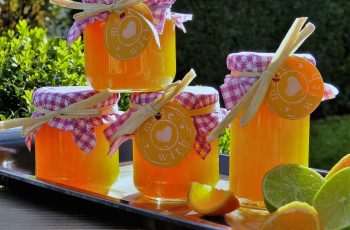Ad Blocker Detected
Our website is made possible by displaying online advertisements to our visitors. Please consider supporting us by disabling your ad blocker.
Imagine being able to prepare a delicious and nutritious meal in a fraction of the time it usually takes. Well, thanks to the wonders of electric pressure cooking, this culinary magic is within your reach! In this article, we will uncover the science behind electric pressure cooking and how it has revolutionized the way we cook. By understanding the mechanics and principles behind this innovative cooking method, you’ll not only discover why it’s so efficient and convenient, but also why it produces mouthwatering dishes that are sure to impress. Get ready to embark on a culinary journey that will leave you wanting more!

Understanding Electric Pressure Cooking
How an electric pressure cooker works
Electric pressure cookers work by utilizing the power of steam and increased pressure to cook food quickly and efficiently. The cooker consists of a tightly sealed pot with a locking lid, which does not allow steam to escape during the cooking process. Inside the pot, there is a heating element that heats the liquid, usually water or broth, to generate steam. As the liquid reaches boiling point, it creates steam, and the pressure inside the cooker rises. This high pressure has a significant impact on the cooking process, resulting in tender and flavorful dishes in a fraction of the time traditional cooking methods would take.
The role of pressure in cooking
Pressure plays a crucial role in the cooking process. By increasing the pressure inside the electric pressure cooker, the boiling point of water is raised. This means that food can cook at much higher temperatures, resulting in faster cooking times. Additionally, the increased pressure forces moisture into the food, resulting in more tender and succulent dishes. This allows flavors to penetrate the food more effectively, resulting in more flavorful meals.
The benefits of electric pressure cooking
Electric pressure cooking offers numerous benefits that make it a popular choice for busy individuals and families. Firstly, it significantly reduces cooking time. With an electric pressure cooker, you can prepare meals that would traditionally take hours in a matter of minutes. This time-saving aspect is a game-changer for those who want to enjoy homemade meals without spending hours in the kitchen. Additionally, the high-pressure cooking process helps to retain more nutrients in the food, resulting in healthier meals. It also enhances the flavors of dishes, transforming even simple ingredients into rich and flavorful creations. Finally, electric pressure cookers are energy-efficient, using less electricity compared to traditional cooking methods, therefore saving money on utility bills.
Heat Transfer in Electric Pressure Cooking
Conduction and its impact on cooking
Conduction refers to the transfer of heat from a hotter area to a cooler one through direct contact. In electric pressure cooking, conduction occurs when the food comes into contact with the hot surfaces of the pot or the liquid inside. This direct heat transfer helps to cook the food evenly and ensures that the temperature reaches all parts of the dish. Conduction is particularly important when browning or searing meats before pressure cooking, as it creates the desirable Maillard reaction, which adds depth and complexity to the flavors.
Convection and its role in pressure cooking
Convection, on the other hand, involves the transfer of heat through the movement of a fluid, usually air or liquid. In electric pressure cooking, convection occurs as the hot steam circulates within the sealed pot. This circulating steam helps to distribute heat evenly throughout the food, resulting in uniform and consistent cooking. Convection is especially beneficial when cooking larger cuts of meat or dishes with multiple ingredients, as it ensures even cooking and minimizes the risk of undercooked or overcooked portions.
Radiation and how it affects food
Radiation refers to the transfer of heat through electromagnetic waves. In electric pressure cooking, radiation plays a minor role compared to conduction and convection. However, it still has some impact on the cooking process. The heating element inside the electric pressure cooker emits radiant heat, which contributes to the overall temperature of the pot. This helps to maintain the high pressure required for cooking and ensures that the food cooks quickly and efficiently.
The Impact of Pressure on Food
How pressure affects the boiling point of water
The increased pressure inside an electric pressure cooker raises the boiling point of water. At sea level, water boils at 100 degrees Celsius (212 degrees Fahrenheit). However, when the pressure inside the cooker increases, the boiling point also rises. This means that the food can cook at higher temperatures than in traditional cooking methods. The higher boiling point allows for faster cooking times and helps to break down tough fibers in meats and other ingredients.
The impact of pressure on food texture and flavor
The high pressure in electric pressure cooking has a significant impact on the texture and flavor of the food. As the pressure increases, the steam penetrates the food more effectively, resulting in tender and moist dishes. The increased pressure also helps to infuse the flavors of herbs, spices, and seasonings deep into the ingredients, creating more flavorful and aromatic meals. The combination of pressure and high temperatures also contributes to the Maillard reaction, which leads to the browning and caramelization of food, further enhancing the depth of flavors.
Breaking down tough fibers through pressure cooking
One of the remarkable benefits of electric pressure cooking is its ability to break down tough fibers in meats and other ingredients. The combination of high pressure and steam helps to tenderize tough cuts of meat, making them incredibly tender and melt-in-your-mouth. The pressure also breaks down complex carbohydrates, such as starches, resulting in creamy and velvety textures in dishes like risotto or mashed potatoes. By transforming tough fibers into tender morsels, pressure cooking opens up a whole world of culinary possibilities.
Safety Measures in Electric Pressure Cooking
The importance of pressure release valves
Pressure release valves are a crucial safety feature in electric pressure cookers. These valves allow the built-up pressure to release gradually, preventing any potential accidents or explosions. It is important to follow the manufacturer’s instructions on how to operate the pressure release valve correctly. Failure to do so can result in dangerous situations. Always ensure that the pressure has been fully released before attempting to open the lid, as the remaining pressure inside could cause steam burns.
Avoiding overpressure situations
Overpressure situations can occur if the pressure inside the electric pressure cooker exceeds the safe operating limits. This can happen if the pressure release valve is blocked or if there is a malfunction in the cooker. To avoid overpressure situations, always check the pressure release valve for any blockages before cooking and ensure that it is functioning properly. It is also essential to follow the recommended maximum fill level for the cooker, as overfilling can lead to excessive pressure buildup.
Managing steam release in electric pressure cookers
Steam release is an integral part of electric pressure cooking. It is essential to properly manage the release of steam to prevent any accidents or injuries. Most electric pressure cookers have a manual steam release valve that allows you to control the amount and speed of steam released. It is crucial to always exercise caution when releasing steam and to keep your hands and face away from the steam vent to avoid burns. Additionally, some recipes may require natural steam release, where the pressure is allowed to dissipate naturally over time. Always follow the recipe instructions for steam release to ensure safe and successful pressure cooking.

Nutritional Advantages of Electric Pressure Cooking
The impact of pressure cooking on nutrient retention
One of the significant advantages of electric pressure cooking is its ability to retain more nutrients in food compared to traditional cooking methods. The shorter cooking times and sealed environment help to preserve the heat-sensitive vitamins and minerals that can be lost during prolonged cooking or boiling. The high-pressure cooking process also helps to retain the vibrant colors of fruits and vegetables, preserving their antioxidants and phytonutrients.
Preserving vitamins and minerals through pressure cooking
Vitamins and minerals play a critical role in maintaining a healthy diet, and electric pressure cooking helps to preserve these essential nutrients. The shorter cooking times and minimized exposure to air and heat result in minimal nutrient loss. Unlike boiling, where some water-soluble vitamins can leach into the cooking liquid, pressure cooking keeps these valuable nutrients locked inside the food. This means that you can enjoy more nutritious meals without sacrificing flavor or texture.
How pressure cooking enhances the bioavailability of nutrients
Bioavailability refers to the body’s ability to absorb and utilize nutrients from food. Electric pressure cooking enhances the bioavailability of nutrients by breaking down the cell walls of ingredients, making it easier for the body to extract the beneficial compounds. This especially applies to plant-based foods like legumes and grains, which can sometimes be challenging to digest. Pressure cooking not only makes these foods more digestible but also increases the availability of vital nutrients such as protein, fiber, and essential minerals.
Time and Energy Efficiency in Electric Pressure Cooking
Reducing cooking time through high-pressure cooking
One of the most significant advantages of electric pressure cooking is its ability to drastically reduce cooking time. Traditional cooking methods that involve simmering or stewing can take hours, but with an electric pressure cooker, those same dishes can be prepared in a fraction of the time. The high-pressure environment raises the boiling point of water, allowing food to cook at higher temperatures, resulting in faster cooking times without compromising on flavor or tenderness.
The energy-saving benefits of electric pressure cooking
Electric pressure cookers are not only time-efficient but also energy-efficient. While traditional cooking methods require constant monitoring and heat adjustments, electric pressure cookers maintain a constant temperature throughout the cooking process, reducing the overall energy consumption. Additionally, the sealed environment of pressure cooking prevents heat loss and allows for efficient heat transfer, further contributing to energy savings. By using an electric pressure cooker, you can enjoy flavorful meals while also reducing your environmental footprint and utility bills.
Meal planning and batch cooking with pressure cookers
Electric pressure cookers lend themselves well to meal planning and batch cooking. With the ability to prepare large quantities of food quickly, you can easily plan and prepare meals in advance, saving time and effort throughout the week. By utilizing the high-pressure cooking method, you can cook large batches of soups, stews, or grains and store them for later use. This not only streamlines your mealtime routine but also ensures that you always have a nutritious and homemade meal ready to enjoy.

Cooking Techniques in Electric Pressure Cooking
Braising and stewing in an electric pressure cooker
Braising and stewing are cooking techniques that are well-suited for electric pressure cookers. In braising, ingredients are first seared or browned to develop flavor and then cooked slowly in liquid to become tender and flavorful. Electric pressure cookers excel at this cooking technique as the high-pressure environment speeds up the cooking process while ensuring the meat or vegetables remain moist and tender. Stewing, on the other hand, involves combining ingredients in a flavorful liquid and simmering them slowly for an extended period. Electric pressure cookers can significantly reduce the cooking time for stews, allowing you to enjoy rich and hearty meals in a fraction of the time.
Steaming vegetables and seafood with pressure cooking
Steaming is a popular cooking method for preserving the natural flavors and nutrients of vegetables and seafood. Electric pressure cookers have a steaming function that allows you to quickly and efficiently steam these delicate ingredients. By using a steamer basket or trivet, you can elevate the ingredients above the liquid and cook them with steam generated from the high-pressure environment. This gentle cooking method retains the vibrant colors of vegetables and ensures that they remain crisp and tender. When steaming seafood, such as fish or shellfish, pressure cooking helps to seal in the natural juices and flavors, resulting in perfectly cooked and succulent seafood dishes.
Making risotto and rice dishes in a pressure cooker
Risotto and rice dishes are notorious for their lengthy cooking times and constant stirring requirements. However, with an electric pressure cooker, you can achieve perfectly cooked rice and risotto in a fraction of the time. The high-pressure environment of the cooker allows the rice to absorb the necessary amount of liquid quickly and evenly, resulting in fluffy and tender grains. The sealed environment also locks in the flavors and aromas of various additions like herbs, spices, or vegetables, creating a delicious one-pot meal. Electric pressure cookers take the guesswork out of achieving the perfect rice texture, ensuring consistently excellent results every time.
Flavor Enhancement through Electric Pressure Cooking
How pressure cooking intensifies flavors
Pressure cooking is known for its ability to intensify flavors in dishes. The high pressure and heat help to break down the complex compounds in ingredients, such as proteins and starches, releasing their natural flavors. This process leads to a more concentrated and robust taste in the final dish. The reduced cooking time also preserves bright and fresh flavors, making electric pressure cookers an excellent choice for capturing the true essence of ingredients.
Infusing herbs and spices in pressure-cooked dishes
Electric pressure cookers are excellent for infusing herbs and spices into dishes. The high-pressure environment allows the flavors of herbs and spices to penetrate deep into the ingredients, resulting in a well-rounded and aromatic final product. By adding herbs and spices at the beginning of the cooking process, they have ample time to release their flavors and meld with the other ingredients. This infusion process adds complexity and depth to a wide range of dishes, from soups and stews to curries and braises.
Creating complex flavors through pressure cooking
Electric pressure cooking offers a unique opportunity to create complex flavors in a relatively short amount of time. By combining various ingredients and allowing them to cook under high pressure, the flavors meld together, resulting in a harmonious and well-balanced dish. Pressure cooking is particularly effective in breaking down the flavors of ingredients that typically require a long cooking time, such as tough cuts of meat or dried beans. The combination of pressure, heat, and a variety of aromatics and seasonings creates a depth of flavor that is difficult to achieve through other cooking methods.
Adapting Traditional Recipes to Electric Pressure Cooking
Adjusting cooking times and liquid ratios
When adapting traditional recipes to electric pressure cooking, it is crucial to adjust cooking times and liquid ratios. The high-pressure environment allows for faster cooking times, so it is necessary to reduce the cooking time compared to traditional methods. As a general rule, for every 20 minutes of traditional cooking time, reduce it by approximately 1/3 when using an electric pressure cooker. Additionally, since the pressure cooker is a sealed environment, it requires less liquid than traditional cooking methods. Reduce the amount of liquid in the recipe by about 1/4 to ensure proper cooking and prevent excess moisture.
Converting stovetop recipes for electric pressure cookers
Converting stovetop recipes for electric pressure cookers is relatively straightforward. Start by following the recommended cooking times for similar ingredients in the pressure cooker’s instruction manual. Use these guidelines as a starting point and adjust as needed. Next, assess the liquid ratios in the stovetop recipe and reduce it by about 1/4 to account for the sealed environment of the electric pressure cooker. Finally, ensure that the pressure cooker is not overfilled, as this can lead to excessive pressure buildup and affect the cooking process.
Maximizing flavors in traditional dishes with pressure cooking
Electric pressure cooking offers a fantastic opportunity to maximize flavors in traditional dishes. By taking advantage of the high-pressure cooking environment, ingredients can achieve deeper flavors and a more complex taste profile. When adapting traditional dishes, pay attention to the spices, herbs, and seasonings used. Take the time to brown or sear meats before pressure cooking to develop rich flavors. Consider adding aromatics like onions, garlic, or ginger to enhance the overall taste. The combination of pressure cooking techniques and the addition of carefully chosen ingredients can take traditional dishes to a whole new level.
Maintaining and Cleaning Electric Pressure Cookers
Proper care and maintenance of pressure cooker components
To ensure the longevity and optimal performance of your electric pressure cooker, it is essential to practice proper care and maintenance. After each use, remove and wash the sealing ring, lid, and inner pot according to the manufacturer’s instructions. Pay attention to any crevices or hard-to-reach areas where food residue may accumulate. Thoroughly dry all components before reassembling the cooker. Regularly inspect the pressure release valve and clean it if necessary. Additionally, check the gasket regularly for any signs of wear or damage, as a faulty gasket can compromise the safety and effectiveness of the cooker.
Removing food residue and stains from the cooker
Over time, food residue and stains may accumulate on the inner pot and other components of the electric pressure cooker. To remove them, fill the pot with warm, soapy water and let it soak for a few minutes. Use a non-abrasive sponge or brush to gently scrub away the residue. For stubborn stains, you can create a paste using baking soda and water and apply it to the affected areas. Let the paste sit for a few minutes before scrubbing. Rinse all components thoroughly before drying and reassembling the cooker.
Ensuring long-lasting performance of electric pressure cookers
To ensure the long-lasting performance of your electric pressure cooker, it is essential to handle and operate it according to the manufacturer’s instructions. Avoid using metal utensils that can scratch the inner pot. As much as possible, avoid placing the inner pot over a direct heat source, such as an open flame or stovetop burner. Regularly check the integrity of the power cord and other electrical components. It is also recommended to periodically test the pressure release valve to ensure it is functioning properly. By following these guidelines and properly maintaining your electric pressure cooker, you can enjoy many years of delicious and hassle-free cooking.

